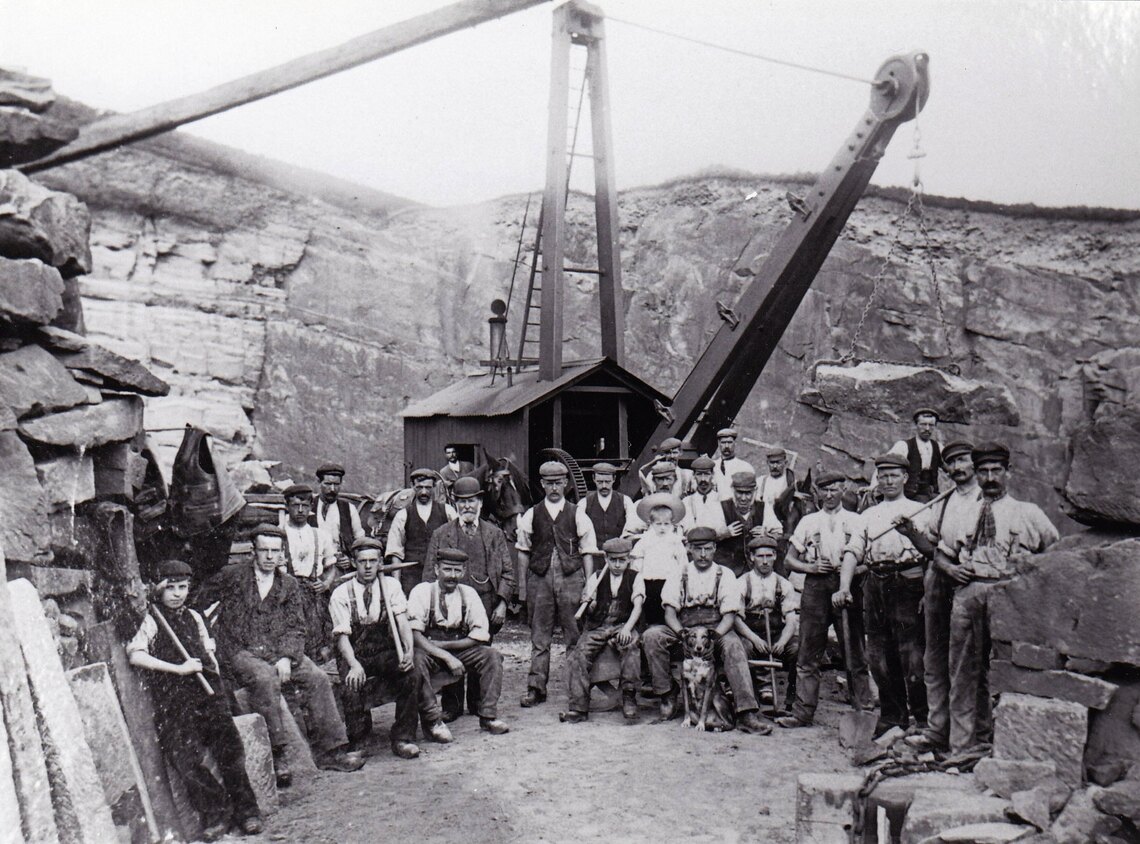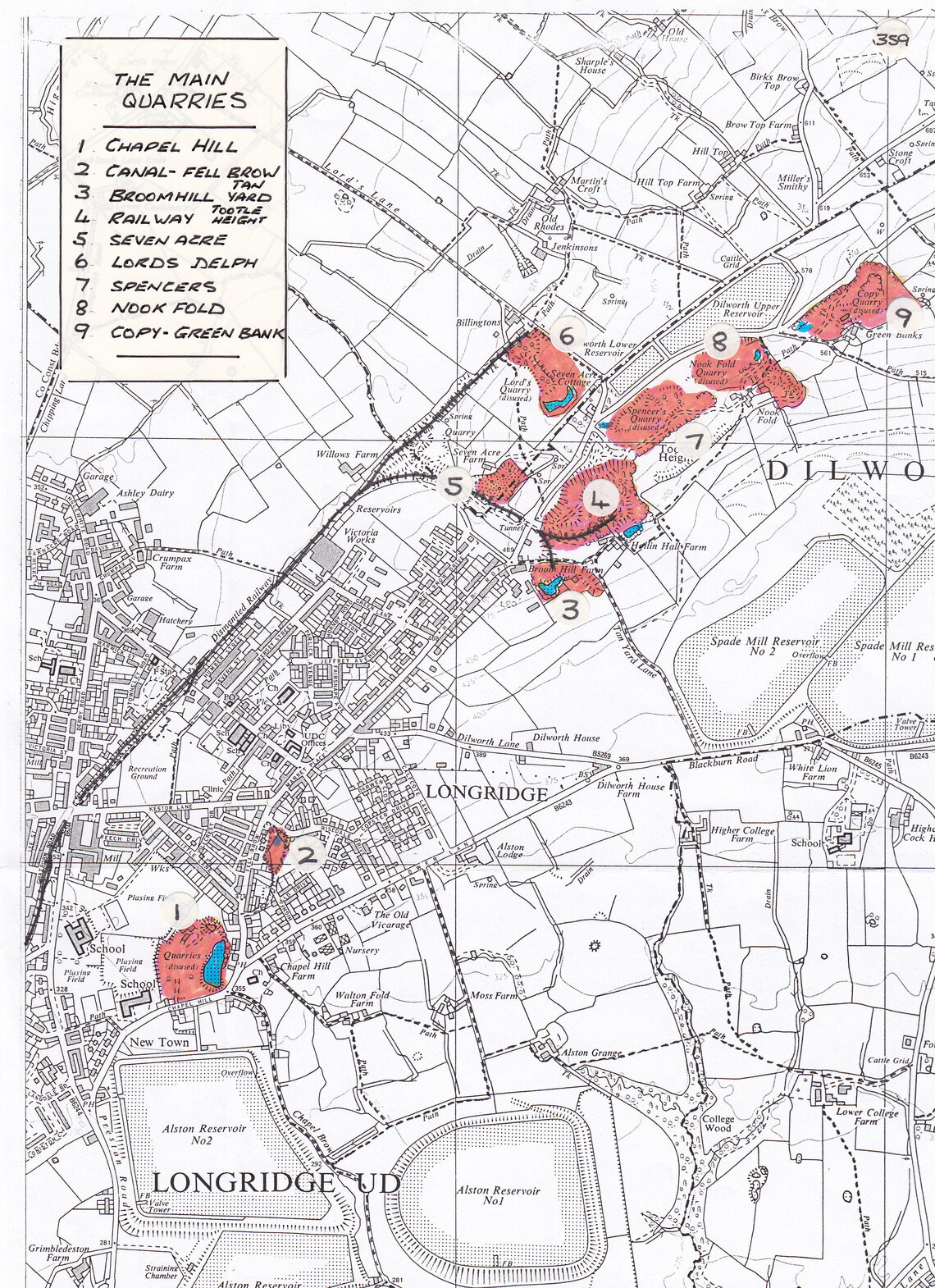Every month, the Heritage Centre submits an article on aspects of local history to a local free magazine, the 'PR Pointer' that is distributed across Longridge and Preston.
Copies of the current and previous articles can be seen below.
April 2024
Longridge stone – the building blocks of West Lancashire
Longridge Fell is formed of millstone grit sandstone, an excellent building material which has been quarried since at least the 1700s and possibly earlier. Known as Longridge Brown, the stone was at first used for building in the village itself. As knowledge of its fine properties spread, quarrymasters forged links with developers across the county to create a thriving market and an expansion in the number and size of quarries spreading up the Fell.
Huge blocks of stone were at first transported to Preston docks by horse drawn ’lurries’ pulled by teams of up to 16 horses for onward shipping. Quarry owner Thomas Fleming was one of the main promoters of the 1840 gravity railway to Preston, converted to steam locomotion in 1848, which facilitated the export of the stone around Lancashire. The major civic buildings in Preston are constructed of our stone, as are the town halls of Blackburn and Lancaster, Bolton parish church and the Liverpool, Fleetwood and Preston docks.
At the height of production the main quarries were Broomhill (off Tan Yard), Railway, Spencer’s and Nook Fold (now together the location of the Beacon Fell View Holiday Park), and Copy or Green Bank , now the site of holiday homes and a well-used ‘bouldering’ climbing face. On the other side of the ridge was Lord’s Delph, close to Billington’s Farm.. The quarries at one time employed 400 men. The railway ran beyond the town as far as Lord’s Delph and through a tunnel under Higher Road to serve the quarries at Tootle Heights; trucks had to be winched by rope through this as engines became too large to get through.
The demand for Longridge stone collapsed by 1918, due to competition from Yorkshire and Wales, the costs of carriage and the increasing use of bricks in building. The last of the quarries closed shortly after the Second World War, although Copy Quarry reopened briefly in the 1970s to supply hardcore for the construction of the M55 to Blackpool. Slightly further afield, Leeming Quarry at Kemple End is still operating and supplied the slab of stone used to mark 100 years since the end of WW1 in the Longridge Rec.
Our pictures shows workers at Nook Fold in 1899 and a line drawing of the local quarries
Our next corridor display will give more detail about our quarrying past. To learn more about the history of Longridge, its industries and commerce, why not buy a copy of ‘Our Heritage’, an A – Z guide to our town, available from the Heritage Centre.
The Longridge Heritage Centre corridor displays can be seen during Station opening times of 9 to 4, Monday to Saturday. The Centre is open between 10 and 2, Monday to Friday. We sell a selection of cards, books, maps, local photographs and small gifts.
March 2024
Victorian and Edwardian Longridge
Our corridor display opening at the end of February is a pictorial celebration of Longridge through the Victorian and Edwardian eras.
Until the middle years of the 19th century, Longridge was a village of mainly home workers – hand loom weavers and nail makers. The only industry of any scale was quarrying, which had been carried out on Longridge Fell on the outskirts of the settlement for centuries. The stone was transported away by horse and cart until 1840, just one year after Victoria came to the throne, when the railway down to Preston opened. This was operated by gravity and hauled back to Longridge by horse power. The population of the village in 1841 was 1652. Steam trains came to the line in 1848 and opened the way for transporting raw materials, especially coal and cotton, up to Longridge. Very soon the cotton mills were built and started production – Stonebridge in 1850, Cramp Oaks (Crumpax) a year later, Victoria in 1862 (shown in our picture) and finally Queens in 1875.
These mills needed workers and workers needed housing. The characteristic terraces off Berry Lane and elsewhere in Longridge began to appear in 1860 and house building continued apace throughout the next decade and beyond. The population increased, at first slowly, but between 1861 and 1871 it grew by 50% to just over 3000. In 1901, the year Victoria died, 4304 people were recorded in the census. These residents needed services and during the last 4 decades of Victoria’s reign schools and churches were built, The Longridge Co-op was formed, the railway station opened to serve passengers (who had previously had to buy their tickets at the Towneley Arms), a gas works came into production and the whole social network of a thriving community was built up. Longridge Urban District Council was created in 1894 to run the affairs of the town.
The Edwardian era lasted just under 10 years from 1901 until 1910. This was a time of stability in Longridge. The population remained at just over 4300, the mills were thriving and life seemed set to continue in this vein indefinitely. The people of Longridge could not have foreseen the disruption to their lives to come in 1914.
The Longridge Heritage Centre corridor displays can be seen during Station opening times of 9 to 4, Monday to Saturday. The Centre is open between 10 and 2, Monday to Friday. We sell a selection of cards, books, maps, local photographs and small gifts.


